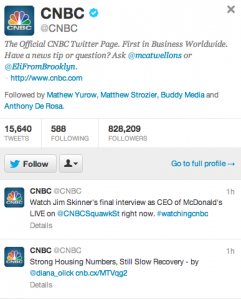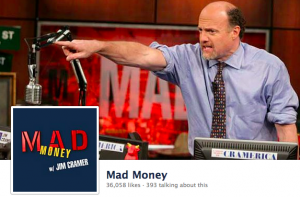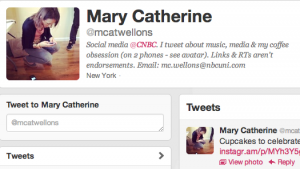This post is part of the Social Media Editor Series, featuring interviews with social media editors from news organizations about what they do and where they see social media in journalism going.
 CNBC Social Media Editor Mary Catherine Wellons doesn’t think age needs be a dividing line between TV viewers and social media users.
CNBC Social Media Editor Mary Catherine Wellons doesn’t think age needs be a dividing line between TV viewers and social media users.
That said, television news does present a unique set of problems for social media editors: most notably, encouraging older users of a traditionally passive medium to participate across platforms, and at the same time, making television news relevant for a generation that’s growing up on smaller and more interactive screens.
According to a series of Pew studies, the average nightly news viewer is 53 and the average age of morning news viewers is 51. Users of leading social media platforms are on average at least a decade younger, with 26 percent of internet users ages 18-29 using Twitter, double the rate of those ages 30-49.
Closing the generation gap
 Wellons, whose job it is to monitor and bolster CNBC’s social media efforts, sees CNBC’s audience moving in both directions, with younger viewers taking an interest in its programming and older users becoming more social media savvy.
Wellons, whose job it is to monitor and bolster CNBC’s social media efforts, sees CNBC’s audience moving in both directions, with younger viewers taking an interest in its programming and older users becoming more social media savvy.
CNBC’s social media efforts began five years ago and have only really accelerated in the last couple of years, according to Wellons, who took her current position in October.
The CNBC Twitter account has more than 820,000 followers; Facebook 224,000.
“We have an audience that’s accustomed to tuning in, turning on the television and interacting with content in a very traditional way,” said Wellons, who graduated from the University of Virginia with a degree in political and social thought.

“Social media gives this audience access to information on multiple platforms and adds an extra layer of interaction,” she said.
These interactions, she said, are growing despite the gaps in user age.
Crossing platforms
She cited Oracle CEO Larry Ellison joining Twitter and the recent Twitter interaction between oil billionaire T. Boone Pickens and the Canadian hip-hop wunderkind Drake as examples of an older generation engaging on social media. (For the record, the first $10K is the hardest.)
A younger generation is tuning in to CNBC’s financial coverage, Wellons said, referring specifically to Mad Money’s Jim Cramer, who has a “really cult young audience,” due in part to his college Back to School Tour.
 To buoy and accomodate its increasingly integrated audience, CNBC has incorporated a social media panel — what Wellons calls the “hub” of CNBC’s social media efforts —on its HD channel, which is available in 53 million US homes, according to CNBC research.
To buoy and accomodate its increasingly integrated audience, CNBC has incorporated a social media panel — what Wellons calls the “hub” of CNBC’s social media efforts —on its HD channel, which is available in 53 million US homes, according to CNBC research.
It showcases, among others, trending stocks on a “Twicker” and staff-curated tweets, including that of CNBC talent, market watchers and viewers alike.
“We’re taking content that’s happing on Twitter and in the social media space and making it visible to the on-air audience,” said Wellons, a former CNBC news associate, reporter and producer. “It’s meant to support what our viewers are seeing on a daily basis.”
Viewers cannot contribute to social media through the channel, but Wellons hopes to get them online by other means.
Creating an active audience
CNBC hosts a weekly Google+ hangout with a reporter and conducts Twitter-related contests in which viewers can submit related tweets that could make it on air. These include “Squawk on the Tweet” segment for Squawk on the Street, the #MadTweets hashtag for Mad Money and the #NailTheNumber sweepstakes for the monthly jobs report.
 “The idea here is to engage directly with our audience and give them an opportunity to take part in our broadcast,” Wellons said.
“The idea here is to engage directly with our audience and give them an opportunity to take part in our broadcast,” Wellons said.
For all the hype about pushing the social media sphere, Wellons, sees social media’s most important virtue as being able to connect on a personal level.
Wellons tweets under her own name and tries to personally respond to as many CNBC Twitter queries as possible.
“I think it’s helpful for our audience to interact with an actual human being,” she said, “not just the brand.”
Photo courtesy of Deidre Schoo/www.deidreschoo.com